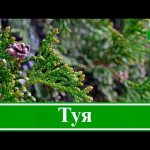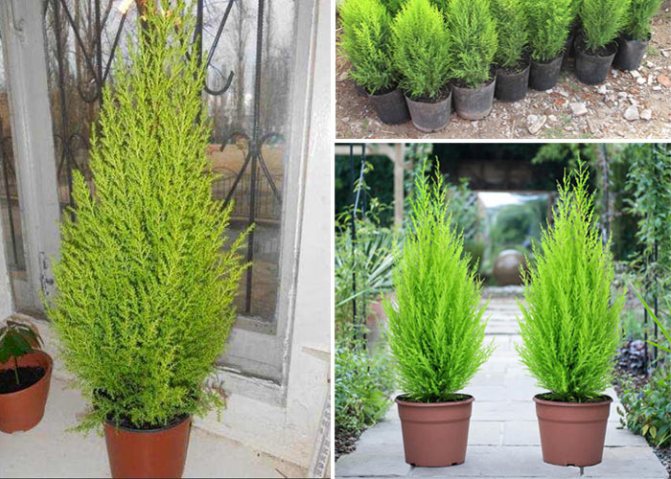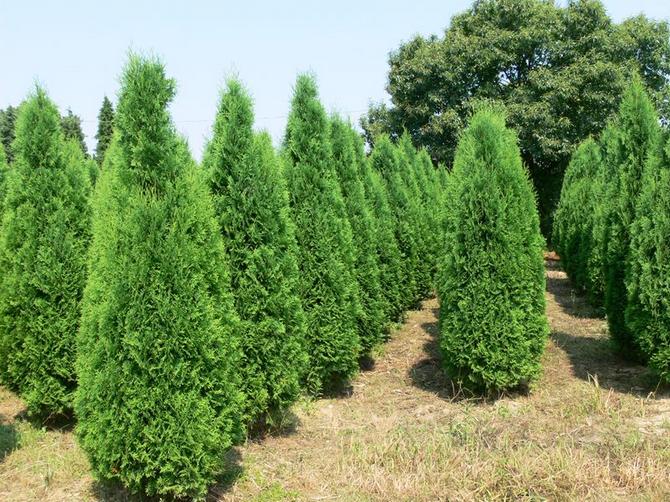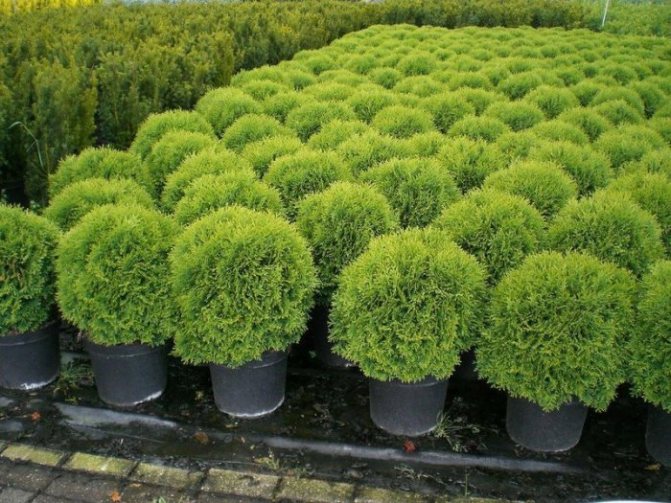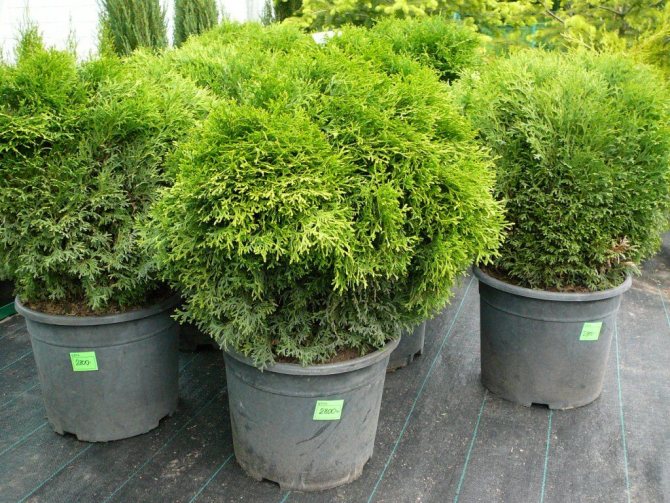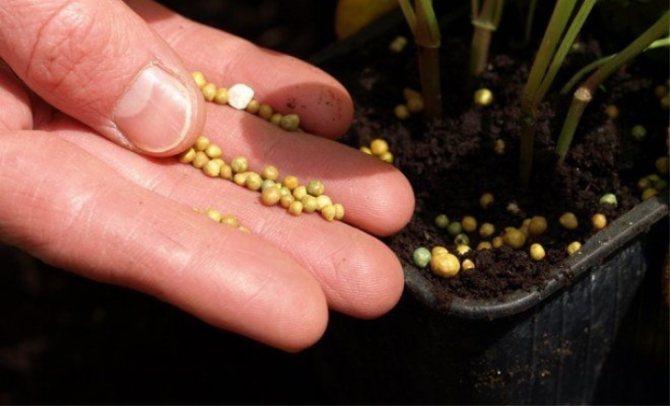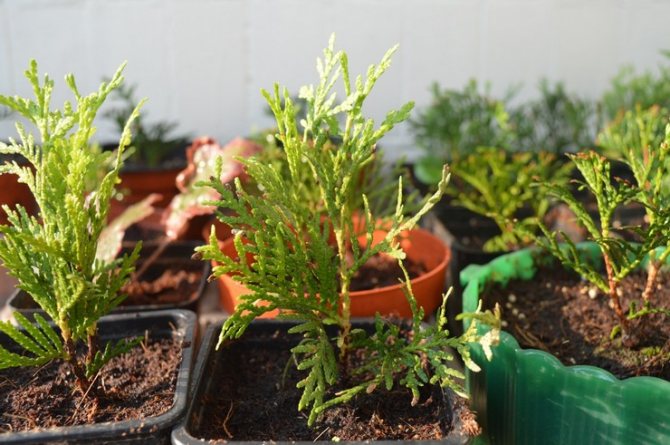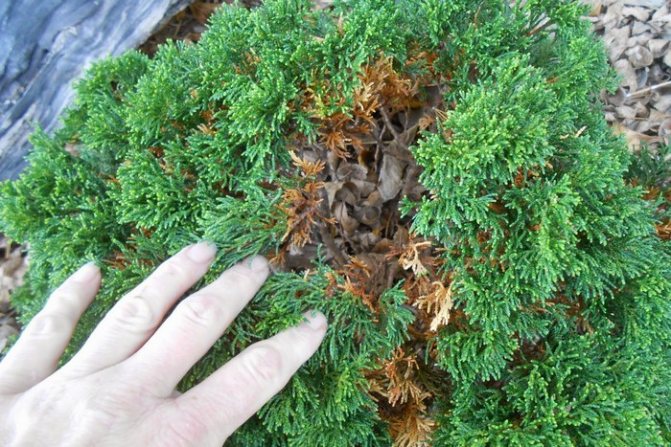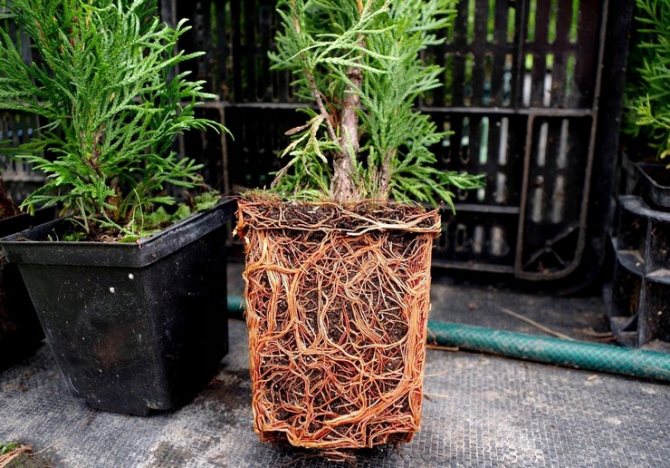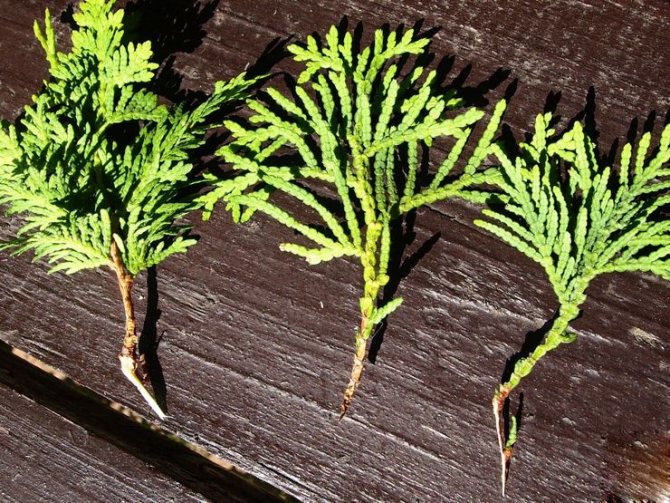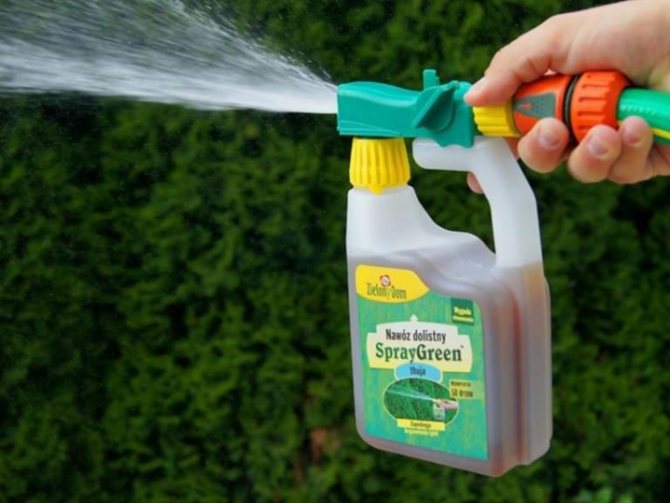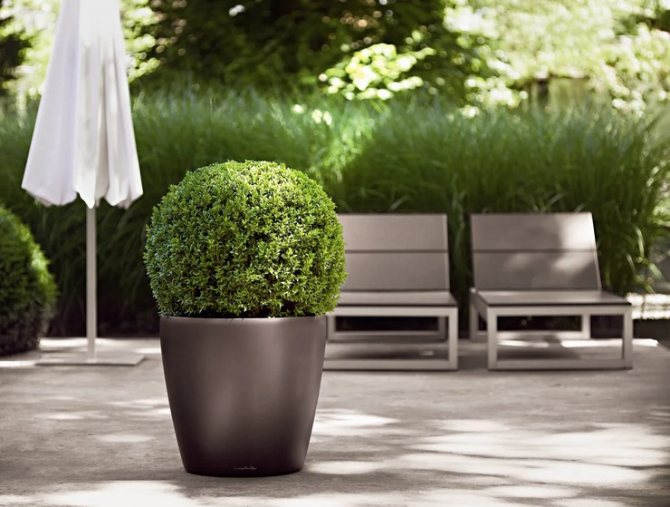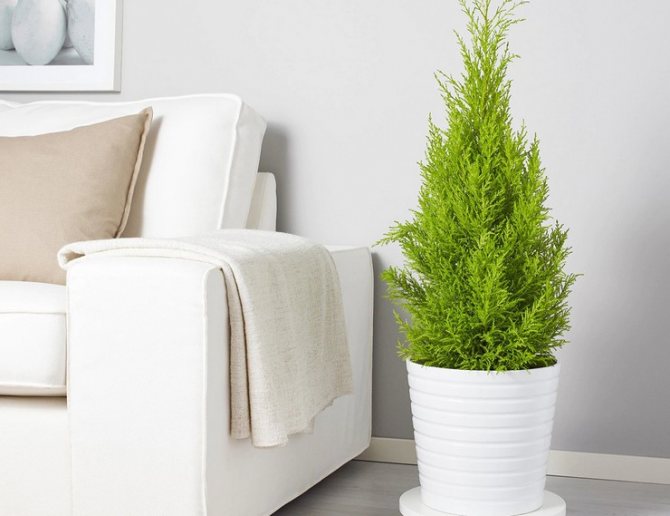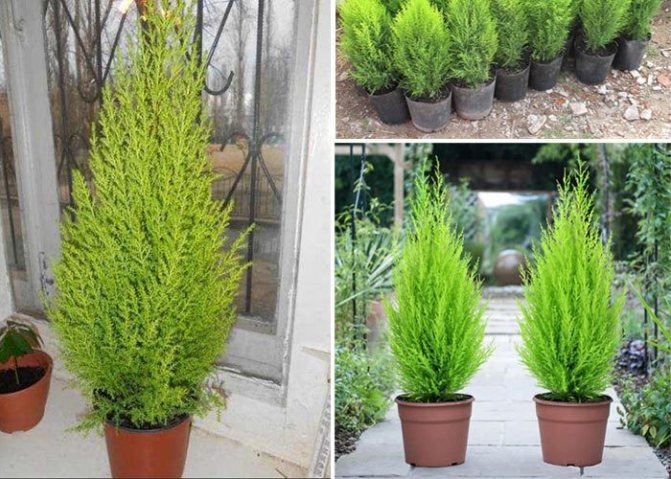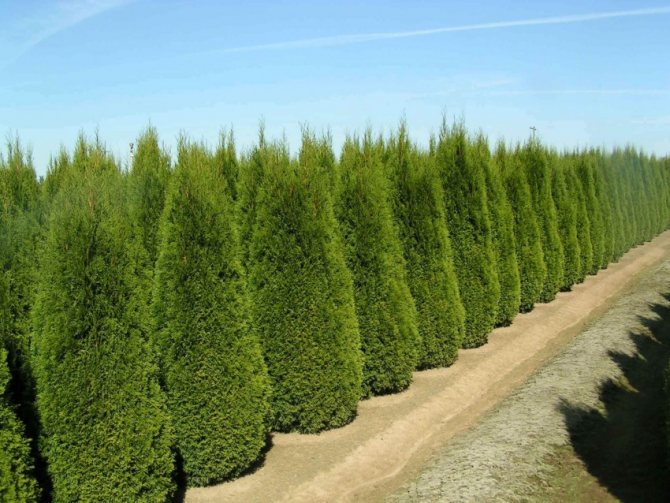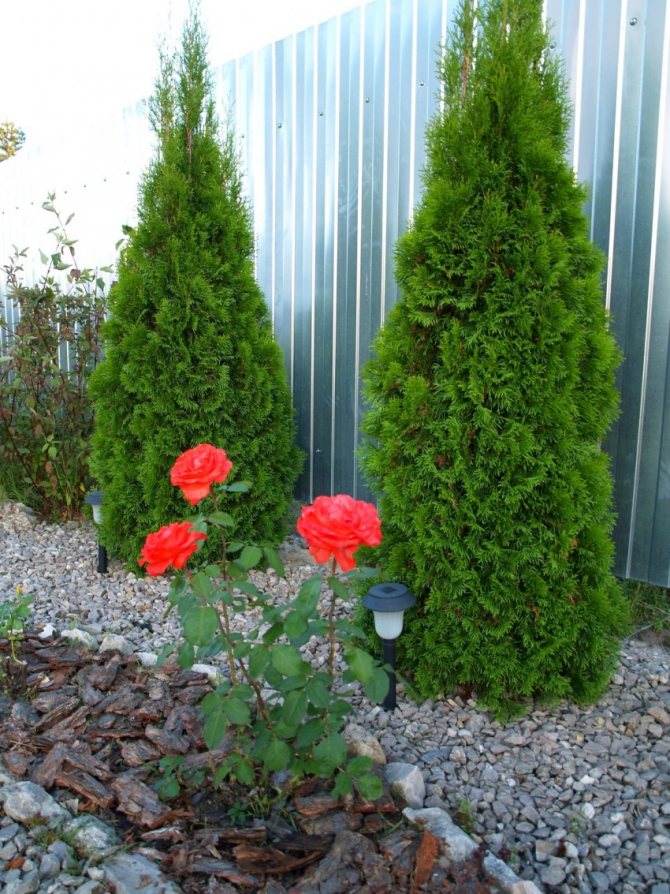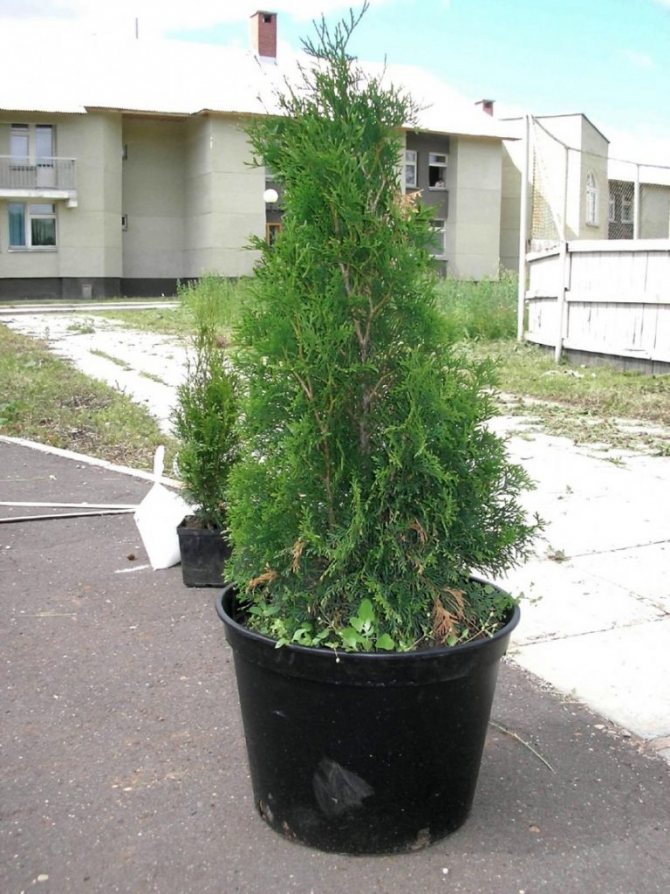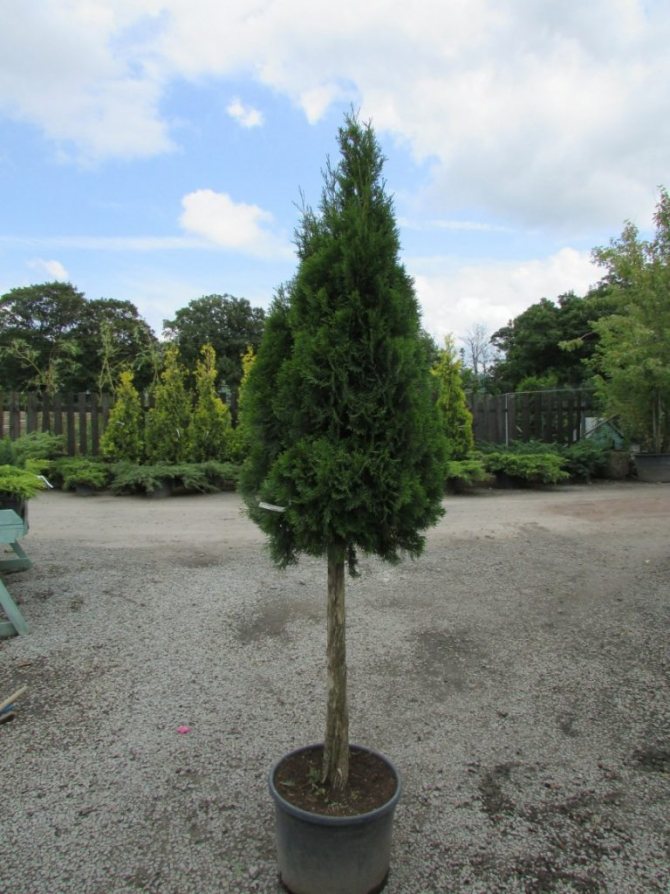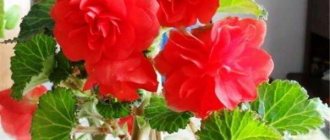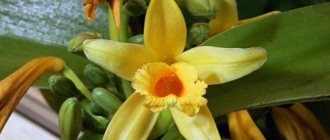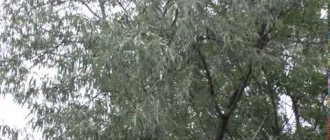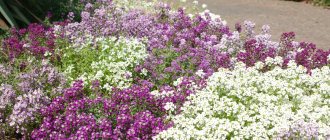Thuja orientalis is the only representative of the genus. In botanical reference books, it is often called biota or flattened. In its natural habitat, this plant can be found exclusively on the hills; in the temperate zone with mild winters, cultivars feel great on flat surfaces. In addition, the eastern thuja biota is not demanding on nutrition and easily tolerates a transplant.
Thuja or flatworm (Platycladus) belongs to the Cypress family (Cupressaceae). It grows in the forests of China, Japan and Korea.
This is a small evergreen, sometimes multi-stemmed tree, 5-10 m in height. In favorable conditions it reaches 15-18 m. The crown is wide-headed.
Lifting branches. When describing the eastern thuja, it is especially worth noting its wide, flat branches (which gave the name to the plant). They are located vertically.
The needles of adult specimens are scaly, light green, tightly pressed to the branches. In autumn, with the first frosts, it acquires a protective brown color.
As you can see in the photo, the cones of the eastern thuja are located on short branches and have an oblong-rounded shape:
Young cones are covered with bluish-green frost. Seeds are wingless, ripen in the second year.
The natural form of the eastern flatfish is quite frost-hardy and suffers only during extremely cold winters.
Description of western thuja
This is a slow-growing tree, reaching a height of 15-20 m, although taller specimens are found in nature, but this is already a rarity. The crown of the western thuja is pyramidal or ovoid, in the original species it is rather spreading. The root system is compact.

The bark at a young age is brick-brown, smooth, eventually turns gray-brown, in a tree with more than a decade of history, the bark on the trunk is in deep longitudinal cracks, fibrous.
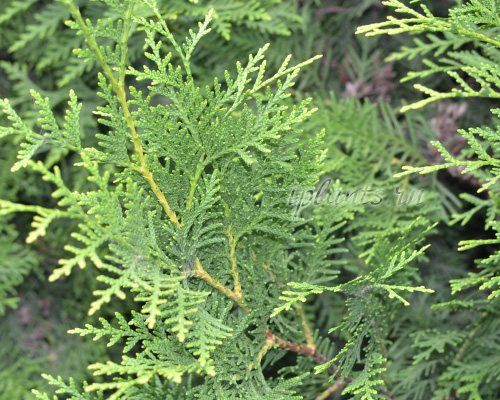

Thuja needles are scaly, green and very small 2-4 mm long, covering the branches like scales. The life of the foliage is a maximum of 2-3 years, then it falls off, but not one by one, but in small branches, the crown is renewed gradually and imperceptibly. By winter, the needles are discolored to yellowish green or brown. The concept of "evergreen" for thuja is relative, if a spruce or pine does not change the shade of the needles at all in winter, then most varieties of western thuja paint the garden in yellow brownish or light green colors.


Flowers are not decorative - monoecious, apical, solitary. Cones are also small, about 1 cm long, ovoid. Each cone contains two yellow winged seeds.
The wood on the cut is reddish, often interspersed with brown, yellow and red veins. The wood is soft and durable, does not contain resin, does not rot and could be an excellent furniture material, but has not found widespread use - this is hampered by too slow mass growth and fibrous bark.
Features of the
Thuja is very popular not only in private gardens, but is also widely used for urban landscaping, since the plant is extremely unpretentious to the ecology of the city: it tolerates gas pollution, dustiness and smoke well. It easily takes root after transplantation, lends itself well to pruning and shearing, some varieties do not require any shape correction at all - they grow by themselves in a pyramid, ball or cone.In addition, western thuja and its varieties are winter-hardy (frost-hardiness zones from 2b to 8b, this is about minus 36 ° C in winter without shelter).
Secrets of the East
Tuya has always been respected among the inhabitants of the East. It was believed that this plant is sacred, it was planted near mosques and holy places. Thuja in translation from Greek means "to sacrifice". In the old days, at the time of sacrifices, logs from this tree were placed in sacrificial fires. The French considered it a "tree of life". She served as a kind of amulet for houses and was actively used as a medicinal plant.
Eastern thuja are phytoncide plants. Their needles release essential oils into the surrounding air, which are destructive for many pathogens. In the wood and needles of thuja, many useful compounds have been found that have a beneficial effect on human health. The seeds of the plant have been used since ancient times as a means of strengthening and toning the body. With decoctions and tinctures, the Chinese treated diseases of the respiratory system, kidneys, liver and bladder. Thuja helped with rheumatism and gout, was a popular styptic and expectorant.
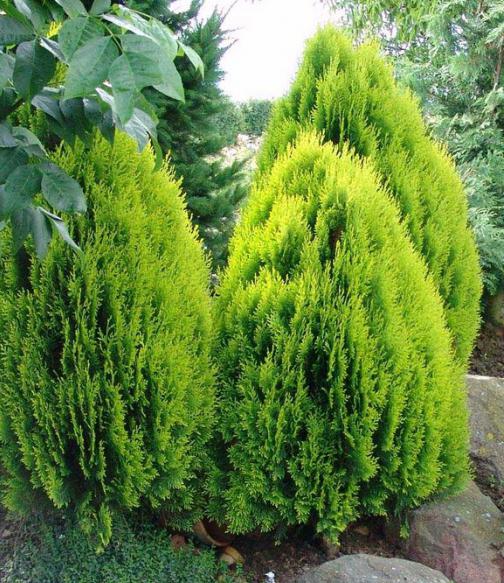

Varieties and varieties of western thuja
The western thuja has several decorative forms:
- weeping
- columnar (pyramidal)
- hemisphere
- spherical
By color of foliage (needles) varieties:
- variegated (several color variations)
- with green leaves
Tall:
- full-grown from 5 m and more
- semi-dwarf from 3 to 5 m
- dwarf - mature trees up to 3 m
- miniature - less than 3 m in height
By frost resistance: there are varieties that freely tolerate winters in central Russia, there are varieties that require mandatory shelter.
Here are some frost-resistant ones:
- Danica (Danica) is a miniature variety up to 60 cm or slightly higher in height, spherical in shape, winter hardiness - climatic zone 3.
- Globoza (Globosa) is a spherical miniature thuja, adult no more than 2 m, growing very slowly, winter hardiness - 3 climatic zone.
- Golden Globe - semi-dwarf spherical, slow growth rate, very frost-resistant - climatic zone 2b.
- Wagneri (Wagneri) - narrow-conical shape, semi-dwarf (up to 3.5 m), fast-growing, winter hardiness - 4 climatic zone.
- Woodwardii ('Woodwardii) - semi-dwarf wide-rounded form, grows slowly, winter hardiness - 4 climatic zone.
- Hoseri - spherical, fast-growing, up to 2 meters high, winter hardiness - 3 climatic zone.
- Brabant - conical, fast-growing, the variety is similar to Smaragd, but the growth rate is 2-3 times higher, winter hardiness - climatic zone 3.
- Sunkist - conical thuja of semi-dwarf growth, growing slowly, very frost-resistant - climatic zone 2b.
- Tiny Tim is a miniature variety of thuja, no more than 1 m high, spherical, growing slowly, winter hardiness - 3 climatic zone.
- Holmstrup (Holmstrup) - conical semi-dwarf variety, grows slowly, winter hardiness - 3 climatic zone.
- Smaragd is a slow-growing columnar variety, 3-5 m high - average frost resistance - if all of the above varieties can be grown in Siberia and the Urals, then Smaragd freezes at temperatures below minus 25-26.
When choosing a variety, consider not only its size, shape and frost resistance, but also its general unpretentiousness. Some do not tolerate shading, even light partial shade, others do not tolerate long thaws in winter (with sudden temperature changes), as this provokes early sap flow. Some varieties practically do not need pruning, others need to be systematically pruned. There are varieties that are extremely sensitive to compaction of the soil surface, do not grow on clean loam, annual loosening and mulching are required.
How to grow thuja from a twig?
When deciding how to dilute thuja, you can find several alternative methods. On the Internet, you can find a lot of information on the question that sounds like this: "How to grow a thuja from a branch?" The "instructions" are based on the same actions as when transplanting with cuttings. However, as elsewhere, there are some nuances. If you are interested in how to grow a thuja from a branch, then the cut of the branch itself must first be treated with a root formation stimulator. This will help the root system develop and establish itself in the new soil.
The pallet with sand should be treated with a 3% solution of potassium permanganate. The twigs themselves should be placed in the holes made in advance at an angle of 45 degrees. Several branches can be grown in one pallet at once. For this, the distance between them should be from 3 to 5 cm.
When replanting with branches, make sure that no direct sunlight falls on the pallet with branches.


Moistening can be done using the same technology as when propagating by cuttings. It will be necessary to plant the rooted branches in the spring or you can keep them in greenhouse conditions until summer. This will make it more likely that your thujas will quickly get used to the new conditions and will survive the first winter more calmly.
Thuja western - place in the garden
Western thuja varieties are quite diverse not only in appearance, but also in needs. Among them there are varieties that are tolerant of the amount of sun, but most prefer to grow in full sun, if possible.


In shady places, the crown forms a loose, sometimes one-sided (if there is severe shading on one side).
In places where there is no sun, it is better to give up growing thuja - they will not only greatly inhibit growth, but also increase the risk of various fungal infections.
If you have a close location of groundwater (1-1.5 m), it is permissible to plant conifers only on an artificial elevation - a bulk hill at least half a meter high.
Thuja from seeds - growing at home
A beautiful, evergreen thuja is a wonderful tree for creating a hedge. It is distinguished by good winter hardiness, unpretentiousness. Dense needles protect the site well from cold winds at any time of the year. However, the price of thuja seedlings often forces you to abandon this option. What should those summer residents who cannot afford to buy thuja seedlings do? There is an exit! You can grow a plant from seeds. Is it difficult to do it? Not. The main thing in the process is patience and quality care. How to grow thuja from seeds? We will learn the answer to this question from the article.
Growing thuja from seeds
Planting thuja western
Planting is carried out in prepared pits, on a site freed from perennial weeds - select all rhizomes of nettle, sow thistle and other weeds for digging.
The root system of western thuja depends on the variety - in miniature it is much less than in full-grown or semi-dwarfs. For example, in thuja, 3-5 m in height, the roots spread to a depth of about a meter, in two meters - 50-60 cm.
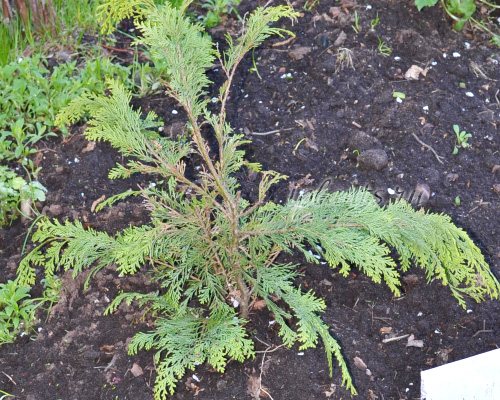

For planting a variety of thuja, which will grow more than 3 m in 10-15 years, you need to prepare a pit measuring a meter by a meter in width and depth, if the soil on your site is not suitable in structure. The planting pit provides a supply of food for the first few years.
Preparing the soil
Thuja prefers soils - medium loam, moderately nutritious, not too moisture-absorbing and not dry, slightly acidic.
If the soil is: heavy clayey, light sandy, clean peat - it requires mandatory improvement. Therefore, you need to mix the earth dug from the hole with other components:
- if the soil is clayey, replace half of the excavated soil with equal parts of peat and sand
- if the soil is sandy, replace half of the excavated land with equal parts of peat and loam (sod land)
- if the soil is peaty, replace half of the excavated land with equal parts of loam (sod land) and sand
At the bottom of the pit we fill in the crushed stone drainage with a layer of 10-15 cm, then we fill in the mixed soil. To plant the acquired plant in a prepared and filled-in hole, we make a hole 30-40 cm wider and 10-15 cm deeper than the root system of the plant (i.e. we make a hole in the filled-in hole).
Next, mix the removed soil in half with humus (manure that has lain in a heap for 3-4 years) and fill the root system of the plant with this soil.
Acidity and liming
You need to know that nitrogen, potassium and phosphorus, like most of the minor elements (iron, magnesium, sulfur and copper), are the most easily assimilated in soils with a pH of 6.0 to 8.0.
For thuja, the optimum acidity is from 6.8 to 7.2, although they tolerate more acidic and alkaline, which is what the suppliers of planting material use, claiming that thuja grow on any type of soil. This is not the case, sooner or later a lag in growth becomes noticeable, the needles turn brown, sometimes the branches or the whole plant dry out.
If the acidity of the soil in your area is below pH 6.5, they should be neutralized to the desired pH with lime or dolomite flour. Read how to do this - soil deoxidation.
How to plant
Water the plant before removing it from the shipping pot. Place the thuja taken out of the container in the center of the hole, spread the roots evenly. Then raise the tree so that the root collar is slightly higher (2-3 cm) than the ground level.
Fill in the prepared soil and carefully compact the soil, pressing down with your hands, just do not squeeze it near the trunk itself. The tree will settle a little with the ground, and the root collar will be flush with the horizon. It cannot be deepened - this will lead to decay.
Now around the tree you need to make a "saucer" for watering - a side made of the ground in a near-stem circle, 5-6 cm high, so that when watering, water does not spread far beyond the root system. If the ephedra is planted on a slope, the "saucer" must be made higher.
It is better to immediately mulch the soil around the thuja with pine bark, chips, for the first time straw is also suitable (not the best option - it lets weeds through and decomposes quickly).
Mulching prevents water from spreading, protects the roots from overheating in hot weather, and retains moisture in the soil for several days longer. Considering that thuja do not tolerate overdrying, mulching is a necessary measure. But at the root collar (10-12 cm in diameter), the minimum layer is to cover the ground by no more than 1 cm, or not cover it at all, so that the trunk does not fall out and does not rot if the weather is too damp.
At what distance to plant thuja
The planting recommendations that you can be given when buying planting material are very contradictory. First of all, you need to decide on the question of whether you are planting in a permanent place or admit the possibility of a transplant.
In general, thuja tolerate transplantation well, especially if the root system is preserved as much as possible, and the time is suitable for such an operation. But sometimes after a few years it will be technically impossible to transplant the trees to a new place. Therefore, plan your garden design ahead of time.
The distance between plants should take into account the final size of the variety and the possibility of crown correction by pruning. For example, in some varieties of columnar thuja, the diameter at the base of the trunk can be almost 2 m, in others - narrow-columnar no more than a meter. Thuja grow slowly, the average growth in height per year is 10-30 cm, in diameter about 5-10 cm. But you need to imagine the garden in perspective, how it will look in 10-15 years, because it will be almost impossible to transplant a full-grown tree.
If you are planning a hedge, say, from the Brabant variety, in which the crown diameter of an adult plant is about 1.5 m, with a planting frequency in a row: every 50-70 cm (such a recommendation occurs) you will have to thin out them after a few years, removing after one. Such large thuja need to be planted at a distance of 80-100 cm.
In addition, you need to take into account whether you want to preserve the natural shape of the planted variety - so that the cone (pyramid) is clearly visible or not - with dense planting, the hedge forms a dense green wall, it is impossible to distinguish individual specimens with the eye.
Another factor is the possibility of curly pruning, there should be enough space around a tree or shrub to freely care for it - strapping, shearing, treatment from diseases and pests.
How to grow thuja - where should you start?
If you think that it is too difficult and it is for you, then we hasten to assure you otherwise. Tuyu can be grown from seeds on your own, in any quantity. It doesn't matter that in the first year the seedlings grow no more than 10 centimeters. In subsequent years, when the root system of the thuja is finally formed, its annual growth is 25-30 centimeters.
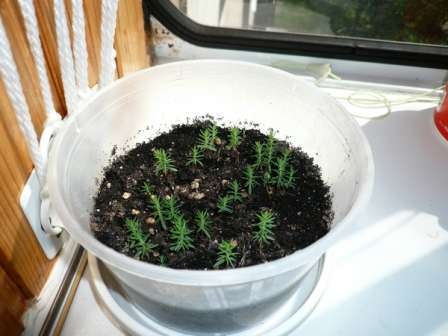

To obtain seeds, thuja cones are harvested in the horse of August - early September, they ripen by this time. You need to hurry to have time to collect them before full disclosure. They are laid out in one layer, the room should be dry and warm. When the dried buds open, the seeds will fall out freely. It is advisable to plant them immediately, since storage adversely affects the germination of seeds. If, for some reason, it is not possible to plant seeds in the fall, they must be stratified before spring planting. Thuja saplings sown before winter grow stronger and healthier than their counterparts sown in spring, grow earlier, winter better, which is especially important for them in the first years of life.
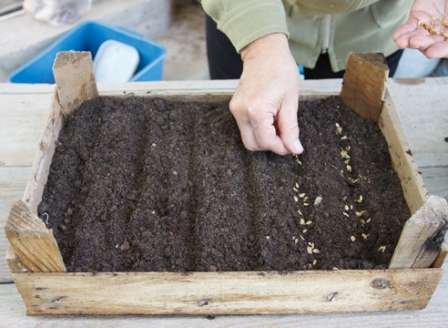

How to sow thuja seeds? Let's consider the most practical tips:
- You can sow thuja seeds directly into the open ground, on the garden allotted for them, or in boxes, it is more convenient to move them around the site. Soil for sowing thuja consists of one part of sod or garden land, two parts of peat and a small amount of sand. It is poured into a box, leveled and compacted so that it is at least 2 centimeters below the sides.
- Then planting grooves are laid, the seeds are evenly laid out in them and covered with soil, which is then compacted. In dry weather, crops should be watered sparingly, making sure that the seeds do not float to the surface.
- The sowing box is placed in partial shade so that in spring the seedlings do not fall under the burning sun.
- In the spring, 15-20 days after the soil is well warmed up, shoots will appear, at first similar to a spruce, this is a feature of thuja, and you do not need to be afraid. Real twigs, with scaly needles, grow from seedlings by the middle of summer.
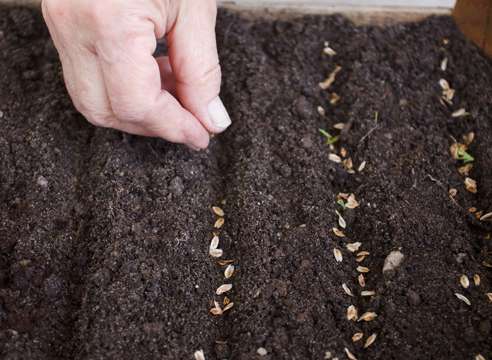

Reproduction of thuja
Thuja western care
Beauty requires an effort - they begin with regular watering, especially the first month after planting - overdrying is unacceptable.
Thuja grows well only on fertile and moist soil. Plants growing in a flowerpot or container do not tolerate overdrying at all. It is more difficult to track the loss of moisture in conifers than in deciduous ones - in those, the leaves hang down like rags, and in conifers they turn yellow and dry. Therefore, watering in the open field should be regular, when there is no rain, approximately once a week.
It is believed that thuja are very well accepted by sprinkling irrigation, water washes away dust from the crown and increases the humidity of the air, but thuja love moist air and grow in nature along the banks and slopes of rivers and reservoirs.
However, during sprinkling, you need to make sure that the water not only drips onto the crown, but also wets the root layer under the trees. If there are signs of a fungal infection on the thuja, try to exclude sprinkling during treatment, carry out regular watering from a watering can.
There are varieties that absolutely do not tolerate both overdrying and low air humidity, for example, Globoza nana (miniature spherical), it is better to plant such varieties near a garden pond, a fountain, a stream.
Improving soil and feeding
After planting, the nutrients of the thuja are enough for several years, as a rule, feeding is not needed for the first two years.
In the future, you can improve the structure of the soil and the fertile soil layer by adding a layer of compost under the trees, 7-10 cm, rake the top layer of earth and replace it with humus, mulch on top with chopped pine bark.
Some varieties, for example, Columna, are sensitive to compaction of the soil surface, the roots do not have enough oxygen, the plants wither, so annual loosening and renewal of mulch is necessary.
If there is no cow or horse humus, you can replace it with leaf humus.
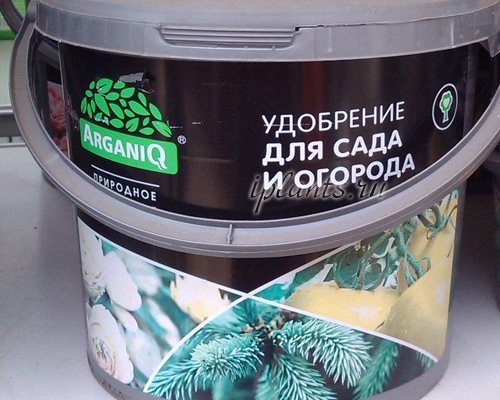

As top dressing, it is desirable to use mainly phosphorus-potassium fertilizers, preferably complex with a set of other minerals, designed specifically for conifers. Usually, two dressings per season at the beginning and end of summer are sufficient.
Do not forget that the introduction of mineral fertilizers lowers the pH, and exceeded dosages can burn the roots, which manifests itself in the browning of the needles, usually not immediately, but within a month.
Inspection of the crown
Thuja western - an evergreen plant, but the renewal of leaves and twigs occurs regularly, as a rule, "leaf fall" happens in the fall, and since the crown of many varieties is very dense, the process can occur unnoticed for us.
Therefore, do not forget to look inside the crown, push the branches apart and choose yellow needles, sometimes it accumulates between the branches near the trunk, gathering in "tangles".
Pruning
Usually thuja lend themselves well to pruning, do not get sick, and only become thicker after cutting.
If a variety has a columnar shape, this does not mean that the plant will grow branches with a strict pyramidal geometry, some varieties, such as Smaragd, have clear outlines of shape, others, such as Brabant, grow shaggy and need constant pruning to form a well-groomed look.
In young plants, just acquired in the nursery, it is often required to reduce the number of leading branches, otherwise the plant grows into two or three trunks (two-peaked) and all decorativeness is lost. If possible, select in advance specimens of columnar thuja with one leader trunk. If there are several of them, leave one, carefully cut the second. The crown will grow over the season.
Trimming the tips of the shoots should be carried out in the spring, with the opening of the buds and until mid-summer, some varieties, especially fast-growing, spherical or ovoid, need to be pruned twice a season, others, slow-growing less often - once in spring, then the crown overgrows a little over the summer, and plants look more natural. You can shorten the branches by 1/3 of the maximum length, or less if necessary.
Shelter of thuja for the winter
Almost all varieties of western thuja need protection from snow and ice. Their branches grow vertically upwards, the snow accumulated and frozen into the ice cap presses on them and breaks them out. Therefore, you need to tie the trunks so that the snow flies off without stopping.
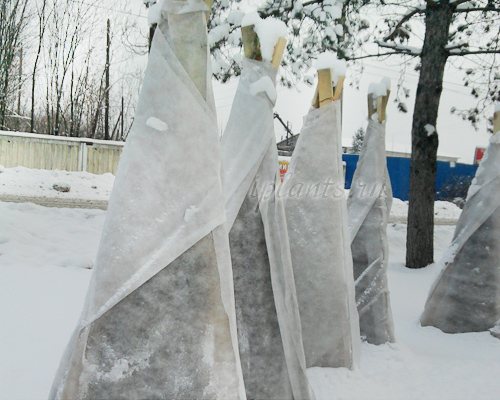

The strapping must be carried out with soft material - nylon tights are just ideal for this role - they do not rot and stretch. You cannot tie the crown too tightly, like Christmas trees before blocking into the body, otherwise the needles inside will rip out.
Small specimens, no more than 1.5 m tall, are best protected not with a harness, but with a hut. Make a tripod from wooden slats and wrap it in burlap or white lutrasil.
It is important to consider the propensity of some varieties to sunburn. There are varieties that are very resistant - the same Smaragd, sometimes the tops of their heads can burn, and there are varieties that require shelter for the most dangerous period - from the end of February to April in the form of burlap or a protective screen.
Sometimes thuja do not burn in the sun for only one reason - they are heavily covered with snow, this applies mainly to young plants and undersized globular, but if the winter is not very snowy, they are threatened with sunburn, so be guided by the weather and precipitation.
Can thujas winter in pots? The main ways to store container plants in winter


In a container culture, annual and perennial plants are grown, therefore, the methods of storing containers in the winter are strikingly different.
Annual plants are simply removed from containers in the fall along with the soil. The soil on the site can be stored in a pile, sprinkled with manure and humus. The heaps of used soil left for the winter will be properly frozen, which will allow the destruction of pests that may be in the soil. The soil will acquire natural moisture by spring, after which it can be reused by adding sand, starter fertilizers and other necessary additives.
After being freed from the soil, the containers must be thoroughly washed, salt deposits removed from the walls, and disinfected. They can be stored in a barn or basement until the next planting.
There are several main methods for preserving perennial container plants in winter, which have proven to be the most optimal options:
| Basement storage | The easiest way to store perennials planted in individual containers is to transfer them in late autumn to existing basements. What you should pay attention to with such storage:
|
| Prikop on the site | This method is suitable for storing trees and shrubs that can winter in natural conditions, zoned for a given climatic zone. To preserve plants in containers, a trench should be prepared, its depth depends on the size of the planting containers. The bottom of the trench is laid out with coarse sand, pebbles or expanded clay, this will prevent stagnation of melt water at the bottom of a dug-in container. The containers, along with the plants, are placed in the trench slightly with a slope so that the moisture formed during the melting of the snow does not accumulate in the pots, they are insulated with peat, and covered with soil. On the top of the earth, they arrange insulation from leaves, sawdust or peat. Sometimes they cover the trench on top with protective films. It is very important to choose the right site for placing the trench - you cannot dig containers into the ground if there is a high level of groundwater at this place. In such a trench, the plants will be exposed to soaking, which will eventually lead to their death. |
| Transferring containers to the greenhouse | The easiest way is to keep the containers with plants in a greenhouse, which will not be very heated until spring. Containers with perennials are placed in an empty place, if necessary, the containers are covered with insulating materials. In the greenhouse, it is useful to maintain the temperature from -3 to + 3C. Sleeping trees and shrubs do not require bright lighting, and rhizome or bulbous plants can be stored in complete darkness. |
| Street storage device | Some container plants can be kept outdoors in winter, protected by building walls. Of course, such storage is only suitable for zoned frost-resistant crops that can winter in a given area. A group of containers is installed near the southern wall of the house, after which a general insulating shelter for the root part is erected. For insulation, you can use sheets of thick foam, while the containers are placed on a foam backing, so you can save coniferous crops in winter, which need lighting during the entire cold period. |
| Making outdoor boxes for storing plants in a lying position | Ornamental shrubs that cannot hibernate in the open field, or their maintenance on the site is fraught with the risk of freezing, can be stored in a supine position in a special box. The box is made of boards. Its dimensions are based on the height of the containers laid on their side, as well as the sizes of the trunks and crowns of the covered plants. To begin with, the crowns of plants are carefully tied and wrapped with insulating material. Then the containers are placed in a wooden box in the "on the side" position, with the crowns to the outer sides of the container. The box is covered with sawdust or leaves, the roots in containers are especially insulated, covering them with bags of sawdust or peat. The box can be covered with a wooden lid, on top of which roofing material is laid. In the northern regions, additional insulation of the wooden box from the outside is carried out. |
| Planting of plants freed from containers in a common trench | In autumn, the plants are freed from containers and planted in a pre-prepared trench. In the spring, overwintered specimens are planted back into garden containers. The method is laborious, while the plants receive additional stress from numerous transplants. |
Reproduction of thuja western
Thuja can be propagated by seeds and vegetatively: cuttings and layering.
Not all varieties reproduce by seeds, and this is rarely practiced due to the possible loss of varietal qualities, in addition, often non-viable seeds that do not germinate are formed in thuja. Some varietals, like Danica, are propagated exclusively by cuttings. Others, for example, Vareana, Malonyana - give a high preservation of varietal traits during reproduction (80-85%).
The seeds of thuja ripen by the end of October, by November, they cannot be stored, they quickly lose their germination - they immediately send for stratification for 2-3 months in a cold place (+ 2-4C) and sow.
Reproduction of cuttings is quite easy if you cut off the branches for rooting in winter. The optimal time is November, not early autumn, but late, if the autumn is long, you can cut it in December, before frost.
Cuttings root in a warm 22-24C, in a room greenhouse, i.e. at high soil moisture.


Alternatively, you can use a zip package - i.e. transparent plastic bag with a zip clip - it is convenient to hang it on the window - can be attached to the glass or frame with tape or on a clothespin.
Rooting technique of thuja cutting
We prepare the soil: 1 part of leafy soil (leaf humus) and 1 part of coarse river sand, or vermiculite and sand in equal parts. For one cutting you need about half a glass - a glass of substrate. We mix the components and be sure to sterilize in the microwave or oven. We put it in a bag and pour it a little with boiled water. The soil for germination should not be too moist, only slightly damp.
Cut the stalk about 15 cm long, preferably with a heel, but do not tear it off (the bark is lifted), but cut it off with a sharp knife. From the cutting, you need to remove the lower branches and place it in a bag in the soil.


Close the package tightly and hang it in a bright place - for winter it is a south window, if the windows are too dark - next to the lamp. It is desirable that the total daylight hours are 12-14 hours.


Since the bag is closed, you do not need to water or spray anything. The roots are formed within a month. Do not remove the stalk from the bag, observe: while the needles are green - everything is in order, wait for the root (it is dark) to be visible through the bag, you can take it out and put it in a pot in a substrate consisting of 2-3 parts of leaf humus, 1 part of a large river sand.


The pot with the planted thuja must be placed in a transparent bag, sprayed with boiled water and tied. After 2-3 days, open the bag for more and more time - gradually accustom to a lower humidity.
Cuttings
In July – August, last year's well-developed lateral branches with a piece of mother wood (heel) are cut off from an adult plant. The lower needles must be removed from them, and then set in water for rooting. To speed up the process, you can use growth stimulants. After the cutting has given a root, it is planted in the prepared soil.
Today, oriental thujas can often be seen both in prestigious office premises and in residential buildings. The plant does not require special attention to itself, it is resistant to cold and drought. Watering the thuja should be moderate, and it is better to place it on the north or west side of the house, avoiding direct sunlight. These plants are not only beautiful - they fully purify the air, saturating it with healthy aromas.
Eastern thuja Aurea Nana
Thuja have only six varieties, but the eastern thuja "aurea nana" has received the greatest recognition as a plant for apartments and offices. It is a small in stature and compact shrub with a conical or ovoid crown. Coniferous leaves are soft, fan-shaped, tightly pressed to the trunk and directed upwards. The “paws” of the needles have a bright light green color, which on young shoots can have a lemon or golden hue. Eastern thujas change their color with the onset of cold weather. The crown acquires carmine-red brown shades.
By the fall, thuja, like many conifers, acquire small cones - seeds. They are only 2-3 centimeters in size, tiny scales armed with curved hooks to protect against intruders. The seeds can be green or blue in color, which will change to brown at maturity.
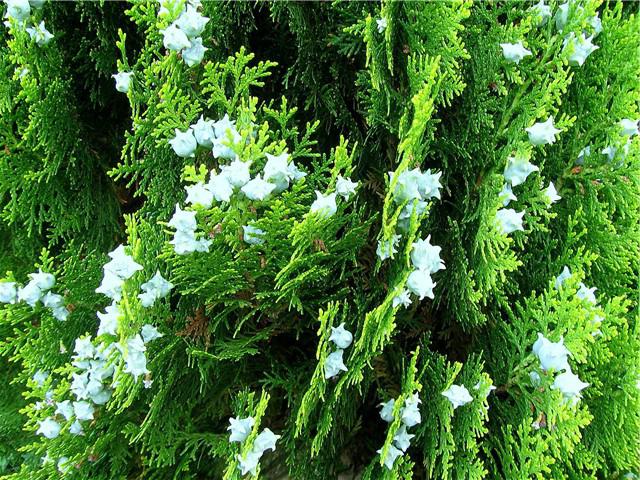

How to choose a variety?
Certain varieties, thuja varieties require areas with sufficient humidity and do not tolerate air pollution, prefer positions from sunny to slightly shaded.
According to the requirements for the soil, the types of thuja differ as follows:
- rootstocks prefer fertile, fresh, permeable soils;
- Western varieties prefer sandy, alkaline soils;
- oriental and giant varieties prefer slightly acidic soils.
Different types differ in terms of climate requirements:
- all species grow well in our climate;
- the eastern species is more sensitive to severe frosts; it is better to plant the eastern thuja in secluded places, avoiding open spaces.
Why is thuja useful?
Together with its decorative qualities, thuja is known as a medicinal plant, the needles of which contain unique substances - phytoncides. They have a beneficial effect on the respiratory system, help relieve the symptoms of colds, bronchitis, tuberculosis. Often, thuja needles are used to prepare infusions aimed at cleansing the biliary tract, removing stones from the bile ducts. It helps well with liver and kidney diseases. Thuja infusions are also used externally. For example, a bath with the extract of the needles of this plant perfectly relaxes, relieves fatigue, relieves headaches and muscle pains, promotes the early elimination of the effects of skin infections, and the healing of burns.
Despite the healing composition, there are certain substances in the thuja needles that act on the human body like poisons. Therefore, the use of tinctures, oils of this plant is recommended only after consultation with a specialist and in moderation. Thuja is not recommended for knitting bath brooms, as it can cause uncontrollable skin reactions (allergies, irritations).
Planting
The soil for planting thuja must allow air and water to pass through. The mixture can be bought at the store or mixed by hand. To do this, you need to mix coniferous (2 parts) and leaf (4 parts) earth with sand (1/2 part).


Dwarf thuja grows well in a pot with a volume of about 30 liters, and for larger plants, a container of up to 150 liters may already be needed. But then it is better to keep the bush outside.
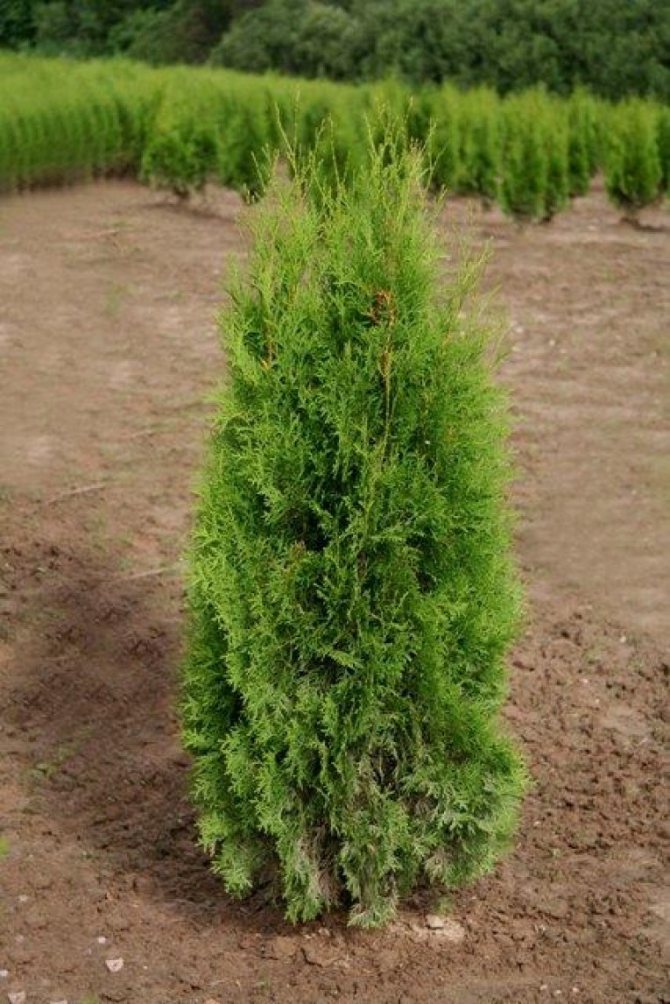

A drainage layer is laid at the bottom of the pot to prevent moisture stagnation near the roots.It is easy to build from pieces of foam or cork pieces. Or just fill in the gravel, though then it will turn out to be just an overwhelming flower pot.
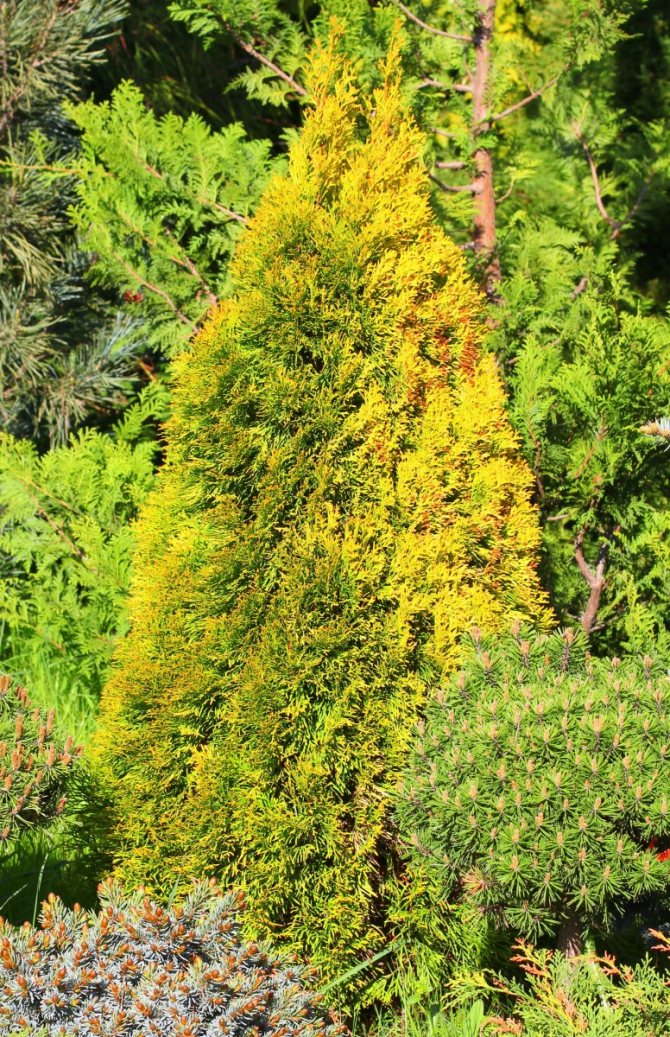

Scope of application
The longevity of conifers has always attracted connoisseurs of plant design. Most of them tolerate heat, drought well, and are resistant to diseases. The same can be said about the eastern biota. The tree planter is great for single planting or group compositions. It is also used as hedges. It looks especially beautiful when its tops are cut.
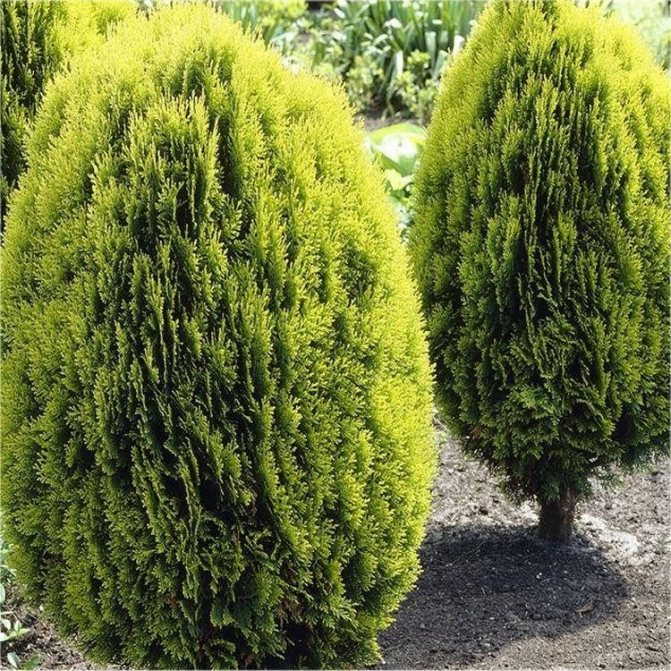

Dwarf varieties are widely used in landscape compositions. Rock gardens, rockeries and mixborders are made with them. Lawns with low varieties of conifers look original.
Plant diseases
Thuja has earned popular recognition also due to the fact that it is extremely rarely exposed to diseases. But if a plant is poorly cared for, it develops in unsuitable conditions, then its "immunity" weakens. Among possible pests on thuja, spider mites, thuja aphids, slugs, snails and other small pests can be found. They fight them with standard methods using special insecticides. Typical diseases of thuja are drying out of shoots, brown shute and some others. The plant is also treated with special preparations.
Features of growing thuja Aurea Nana
In order to grow a beautiful and healthy thuja nana shrub, planting and care must be fully studied. It is from the correct observance of all conditions that the full growth of this plant will depend. It grows well in areas with neutral, slightly acidic, rocky soils, as well as with artificial substrates. In addition, it firmly tolerates drought, but at the same time calmly withstands the close adhesion of groundwater.
What attracts us to thuja western Yellow Ribbon?
Growing area
In nature, this plant can be seen in mountainous regions, where stony soils with a varied and complex relief prevail. Biota can grow in groups or in a single specimen, sometimes in mixed forests with poor soil. Initially, the eastern biota was found mainly in China, then migrated to neighboring regions. Currently, it can be seen in the Crimea, Central Asia and the Caucasus. The plant thrives in warm, temperate climates. Another scientific name for the ephedra is the oriental flatworm. In the wild, there are thuja in the form of shrubs and trees that grow up to 17 m in height.
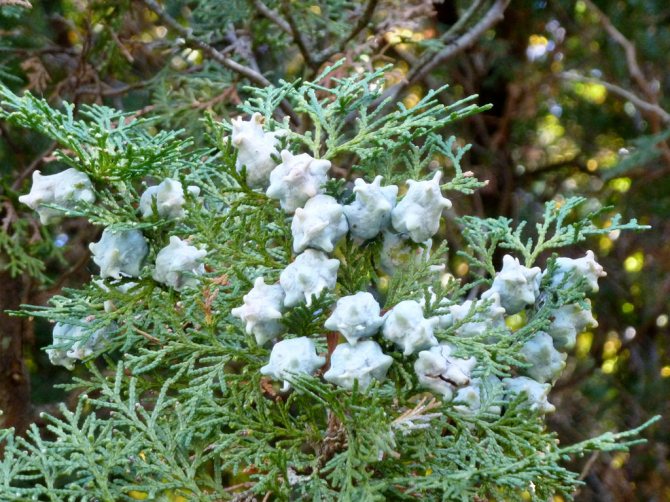

Cuttings
This is a much faster way, moreover, it guarantees the preservation of varietal traits, whereas during seed propagation they are often lost.
Terms of cuttings
In the spring, thuja shrubs come out of winter suspended animation, and the branches receive a signal to begin vigorous growth. Therefore, it is best to harvest cuttings for propagation from the end of March to the end of April, when the branches are ready to take root.
The second option is cuttings in the fall. A cloudy day in mid-October should be chosen, when the juices in the trunk slow down the movement. Such processes take longer to take root, but they are more reliable, they will not have a water shortage.
Correct cutting of cuttings
The upper part of a healthy strong plant is suitable for harvesting cuttings. It is undesirable to cut them off at the bottom: this is fraught with a curvature of the trunk of the future seedling.


Suitable shoots 10-15 centimeters long are located at the ends of the shoots, and their stems are covered with young bark.
If the bark is old and rough, the cutting will not take root. Shoots with smooth stems, without bark, are not yet capable of rooting.
The twig should be torn off manually, moving from top to bottom, together with a strip of bark - "heel". It has accumulated useful substances that will nourish the cutting for some time.
With proper execution and subsequent care, the rooting of thuja does not present any particular difficulties.
Preparing cuttings
It is undesirable to store cut cuttings for a long time. If the need arose nevertheless, you need to place them in a dark room, having previously wrapped them with a damp cloth. But it is better to start planting as early as possible, before properly preparing them:
- To clear the bottom of the stem from branches and a layer of bark - they can start to rot.
- Treat with a root growth stimulant - place the cuttings in it for 12 hours.
Soil preparation
For rooting cuttings, clean river sand or loose land mixture is suitable, which can be purchased in a store or obtained by mixing sand, peat and deciduous humus in a 1: 1: 1 ratio.
Disinfection is necessary: a pale pink solution of potassium permanganate is added to the soil, and the sand is boiled.
The soil is placed in a shallow seedling pot with holes for air in and water out.
Rooting process
Provided that both the soil and the cuttings themselves are ready, you can start planting:
- The twigs are placed in the ground a couple of centimeters, but not straight, but at an angle of 45 °.
- The distance between the cuttings should be at least 5 centimeters.
- The soil around the base of the cuttings is slightly compacted and moistened.
- The pot is covered with plastic wrap or a plastic lid.
- Signs of successful rooting are new shoots on cuttings.


Rooting in potatoes
Among plant breeders, a non-standard way of rooting thuja cuttings is also common - in a potato tuber:
- Healthy medium-sized potatoes are washed and peeled.
- A hole about four centimeters deep is pierced with an awl or nail, where the end of the branch is pushed.
- The potato is placed in a nutritious soil in a wooden box.
- The scion is covered with a dome of half a plastic bottle.
- When watering, the dome is not removed, but the bottle cap is unscrewed.
Caring for planted cuttings
Thuja seedlings should preferably be kept at temperatures from + 18 ° to + 23 ° C and air humidity of 70%. In this case, the room must be systematically ventilated.
In addition, it is necessary to provide diffused lighting, but in no case should direct sunlight be allowed on the seedlings.
In bright light, the plants begin to dry out, their needles turn yellow and fall off.
Watering is done as the soil dries up. Excessive amount of moisture thue is contraindicated. It is advisable to water with a spray bottle to prevent the needles from getting wet and blurring the "heel" of the cutting.
After the appearance of the first young shoots, it is necessary to begin to open access to fresh air for the seedlings, gradually increasing the ventilation time. Thus, young plants get used to new growth conditions.
Pot transfer
For transplanting a thuja to a permanent place, a pot of any type is suitable.
You should not take too small a capacity, which can limit the growth of the root system. You also need to make sure that there are enough holes in the bottom for water to pass through.
Algorithm:
- Drainage is poured to the bottom - for example, expanded clay.
- The transplant is carried out together with a root ball.
- A slightly acidic ground mixture is poured. You can prepare it yourself by mixing sand, coniferous soil and leafy soil in a 1: 2: 4 ratio, respectively.
- The level of the soil in relation to the stem should remain the same. Also, do not compact the soil around the stem too much.
It should be borne in mind that for subsequent transplants (and they need to be done once a year or two), it is better to use soil of a different composition. For adult plants, a mixture of sand, peat and turf soil in a ratio of 1: 2: 2 is recommended.
We grow at home
Cutting and sowing seeds are two ways thuja propagates. Growing at home does not require special attention and effort, but it is worth considering that the plant will grow slowly. For a year, the shrub adds no more than 8-10 centimeters in growth.
Certain subtleties should also be taken into account.There are about 60 varieties of thuja. All of them can differ both in color and in the shape of their crowns. When propagated by seeds, seedlings can differ significantly in shape, color and type of needles from the parent plant. If you want your thuja to have a certain appearance, you should stop at grafting. This method will allow you to get a plant with maternal data. For example, the eastern thuja is presented below - a photo of cuttings already rooted and planted in the ground.
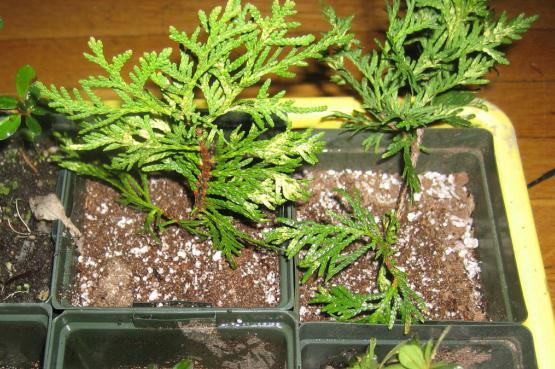

Planting and breeding
Usually, indoor thuja is grown from seeds that must first be soaked in water.
It rises quite quickly, usually the seed hatches in a day. After that, the shoot should be transplanted into a small pot, and after about a year, when the plant grows up, it is already planted in a larger pot.
Many make a mistake and use ordinary land from the garden for planting room thuja. This should not be done.
Note: it is recommended to use soil specially designed for conifers for planting.
This is due to the fact that it contains peat and sand additives, which are necessary for the emergence of thuja and its subsequent growth. Remember one more important point, you should transplant thuja in the spring, around mid-April. Previously, this should not be done.
You can often hear the question - how to propagate thuja? Reproduction of this evergreen houseplant takes place with the help of seeds, layers and cuttings.
If you intend to grow thuja from seeds, then prepare and warm up the sand in advance. Air humidity and temperature should be high.
When making a transplant, it is necessary to make high-quality drainage in advance. In order for a young seedling to take root, a special mixture is required, which consists of coniferous and deciduous soil, as well as sand.
If the plant is already adult, then the composition of the earth will require a different one, which will consist of sand, peat and sod land.
Culture properties
Purslane - what kind of plant does it look like, description
Interesting! Everyone saw how thuja blooms, but few knew that the small bumps that appear after are berries, which in many countries are used as a source of valuable essential oils. The oils are extracted from the fruits of mature trees that have been developing for over 15 years. It is possible to isolate oil only through steam distillation of the knobs. The resulting oil is yellowish, with a pronounced smell of needles. The bulk of the production of such products is concentrated in America and Canada.
Such products are actively used in the pharmaceutical and cosmetic industries. The composition of the needles is useful for the human body and is used in the treatment of many problems. The chemical composition of the oil is especially valuable:
- Tannins, which have astringent, anti-inflammatory, hemostatic and bactericidal properties;
- Sesquiterpene alcohol - expands the bronchi, eliminates cough reflexes, affects the nervous system;
- Thujon is a neurotropic poison, poisoning with which provokes hallucinations, convulsions of the limbs and damage to certain brain tissues. In moderate doses, the poison is beneficial and even necessary for the body;
- Resin, thujic acid, tannin, ascorbic acid - all of this is a good tonic, strengthens the immune system, eliminates microorganisms, promotes wound healing and pain relief.
brief information
Thuja's natural habitat is North America, East Asia. Belonging to conifers is characterized by very original foliage in the form of scales (in young seedlings, leaves are in the form of needles).
Thuja benefits:
- evergreen, looks great on a hedge;
- easy to care for, does not require many procedures;
- resistant to frost;
- rarely exposed to pests, diseases.
Thuja are evergreen trees, less often bushes with a conical or columnar crown.
More than 90 different varieties of thuja give ample opportunities to use them in garden compositions. Varieties differ in height, shape, color of needles, they are:
- rather tall trees and undersized dwarf shrubs;
- slender and squat;
- green and yellow;
- various crown shapes - pyramidal, cone-shaped, spherical, columnar, cushion-shaped.


Thuja grows quite easily and is less susceptible to disease than other conifers, but does not withstand prolonged drought.
Species overview
Thuja belongs to the type of Asian cultures. There are such main types of it:
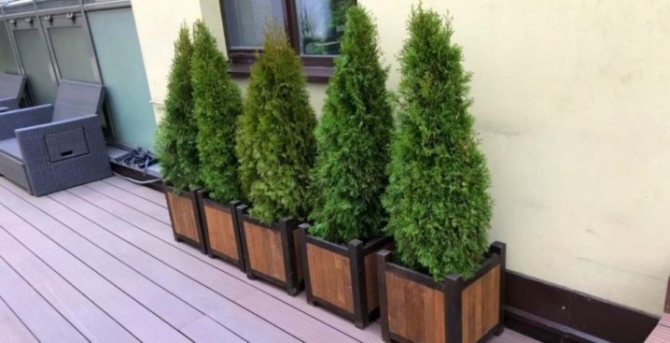

- Japanese;
- western and eastern.
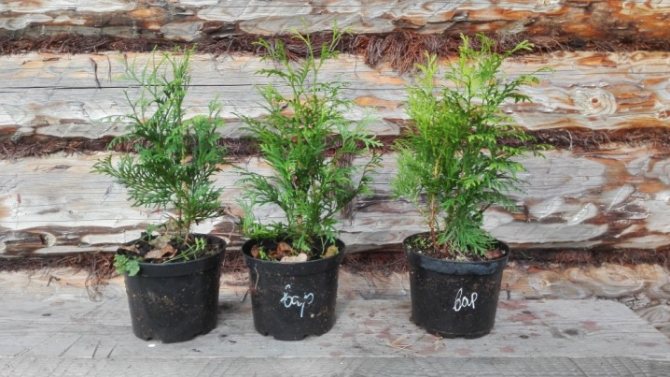

Chinese and Korean thuja most often grow in their homeland. Their needles are very soft and spreading. Branches can be silvery or dark green in color. The length of the leaves reaches 18-20 mm, and the cones grow up to 8-10 mm. The shape of the leaves resembles a triangle.
In our country, Chinese and Korean thuja are planted mainly for greening cities in warm southern regions, or they are grown in apartments and houses at freezing temperatures. The hardy Japanese thuja can grow up to 2 meters in height. Its needles are beautiful and soft to the touch. In Russia, it has taken root well, because it is able to do without wet soil for a long time and firmly tolerates small frosts if it remains on the balcony at low air temperatures. Folded thuja grows in the form of a shrub, reaching 1.5-2 meters in height. It is very unpretentious in content. The western variety of this plant looks both in the form of an ornamental tree up to two meters high, and in the form of a shrub up to 1.5 meters. The needles of the plant are scaly, and the bush is not spreading, its branches hang down.
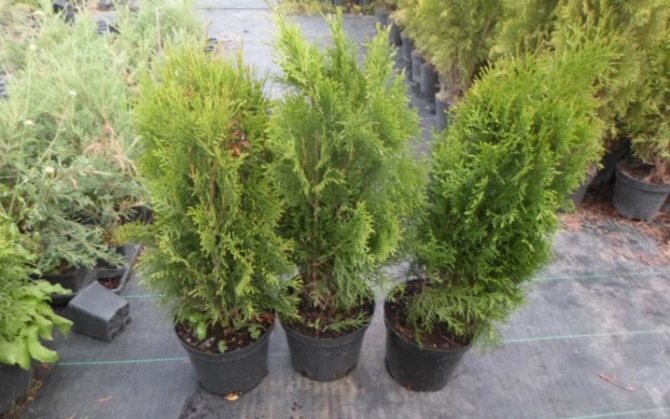

Eastern thuja differs from others in that it can be grown not only in tubs, but also in small pots at home. Scientists managed to get a wide variety of decorative dwarf species, differing in color and size of leaves, as well as the height of the plant itself. Thuja leaves are blue, green, golden and have a silvery tint. The most popular plants for planting in a pot are varieties:
- "Folded Vipcord";
- "Eastern Aurea Nana";
- "Miriam";
- "Eastern biota" and others.
The main feature of the eastern type of thuja is its slow growth. Indoor thuja blooms during May. When ripe, its cones have a green-blue tone, and already in April, in the second year of the tree's life, they acquire a reddish-brown hue. Cone seeds are similar to wheat grains. As a greenhouse, balcony or room landing options are used:
- cone-shaped (heather-shaped), spherical thuja;
- pyramidal plant;
- a tree in the shape of a weeping willow.
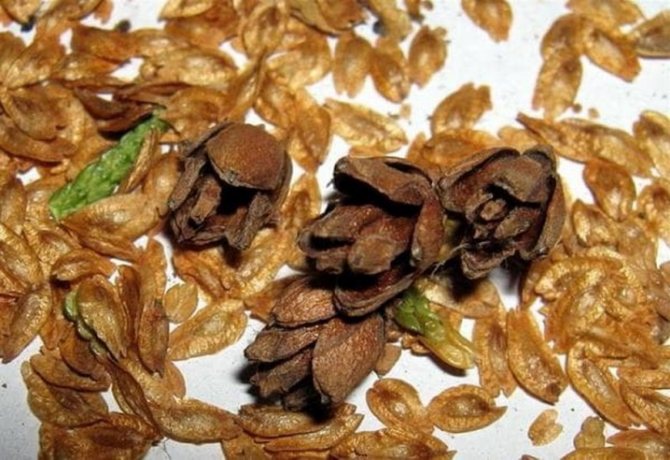

A miniature cone-shaped tree grows rather slowly and grows up to 1.5-2.5 meters. Its crown is like an egg. Coniferous needles are short, green and blue in color in summer, and have a bronze tint in winter. The most famous varieties of this thuja are "Golden Tuffet", "Mr. Bowling Ball", "Filiformis", "Teddy".
Globular thuja is a shrub plant that is dwarf. Thuja grows slowly, up to a maximum height of 1-1.5 meters. The crown is round, thick, resembling a ball or egg. With the change of seasons, the color of its needles also changes. In summer, the bushes are dark green, and in winter their color is painted in a bronze tone. Popular samples are considered "Danica", "Globoza", "Hozeri", "Stolvik", "Little Champion" and other varieties.
Thuja in the form of a pyramid grows no more than 1-2 meters up during the entire period of life. The shrub grows slowly. The color of the needles is predominantly golden at a young age, but acquires a green tone as the plant matures.
The Weeping Willow variety is characterized by bent branches and a disproportionate crown. Its color in summer is bright with blueness, and with the approach of cold weather the needles become duller. Thuja grows up to 1-1.5 meters.Its top is flattened, reminiscent of a dome. Popular are the varieties "Pendula", "Umbrakulifera" and other thuja shrubs.
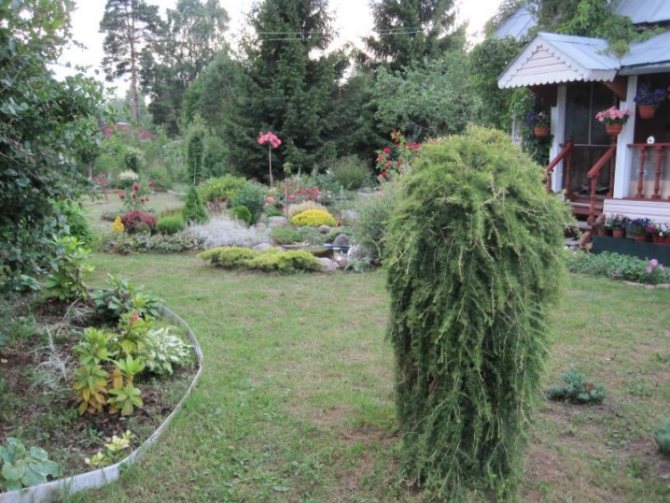

Thuja in the winter at the dacha
Fall
In order for the tree to remain spectacular and not hurt, it is necessary to fully prepare the plant for winter. Despite the fact that most varieties of thuja live without problems at subzero temperatures, experts still strongly recommend covering this conifer for the whole winter. This complex of preparation is carried out in November, until the first snow fell.
How to cover thuja
Basically, only young thuja with fragile shoots are covered. White material is used as cover. A bag made of a material that fits over the branches is ideal without being pulled tight. If you do not cover the thuja, then the upper branches of the tree can deform under the pressure of the snow, and so it simply rolls down the flooring.
To keep the roots of the thuja warm, the leaves are mixed with the ground. They protect the roots from the cold and retain water, and when they rot, they serve as additional fertilizer.
Oversized plants do not need shelter.


Covered thuja.
Wintering thuja
In order to avoid the needles heating up in winter, it is necessary that the tree is not covered with snow. Under no circumstances should it be thrown over trees when clearing paths. The most common misconception is that the trees should be warmer this way. It is not true!
Before winter and early spring, it is necessary to water the plants abundantly, thereby saturating the soil with moisture. You need to wait until the snow melts, and on the street the thermometer will stably show above zero. In addition, you should think about installing protective structures that will create shade for the thuja, protecting it from the scorching sun's rays.
It is not at all necessary to make a shelter with your own hands. You can just buy a ready-made structure in a special store. This design is not expensive.
It is worth noting that neglect of the thuja's preparatory measures for wintering can turn into an unpleasant surprise in the spring. Most often, improper preparation or its absence leads to drying out of the bark and crown of the plant, dropping and changing the color of the needles, and other defects.
Top dressing
If the plant is planted in well-prepared soil, then 1 - 2 additional fertilizing per year will be enough. In the spring, nitrogen-containing mineral fertilizers (ammonium and calcium nitrate, urea) are applied. At the end of summer - calcium and fertilizing containing phosphorus (superphosphate, nitroammofoska)
Complex fertilizing for long-acting conifers works well, for example "Kemira" and "Osmokot".
It is important to know: if the fertilizing was made during planting, then the next fertilizing should be carried out in 2 years.
Where to place the thuja in the house, what temperature does it need
The pot with the plant should not be exposed to the sun, the rays can burn the needles. On the windowsill of the sunny side, the thuja will also not be comfortable, the leaves will begin to turn yellow and crumble. The optimal place for a plant is partial shade, diffused daylight.
You can put the thuja pot in a flower stand and place it near the window. Another option for protection from direct rays of the sun is to fit the window glass. In this case, the thuja will grow beautiful and green.
In the warm season, the thuja can be put on a balcony or loggia. Also, the pot can be taken out into the garden, but placed in the shade.
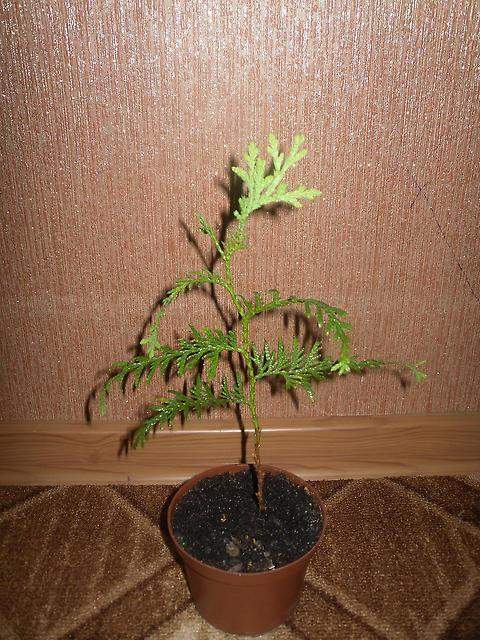

The air temperature that suits the plant is 18-25 degrees. In winter, it is recommended to keep the pot away from heating objects. The temperature in winter should not drop below 15 degrees Celsius. If the balcony is glazed, the thuja will be comfortable on it.
Pruning
It is produced mainly for sanitary purposes. Dry, diseased or damaged shoots are harvested. The main pruning is done in spring, in dry weather. Also biota is suitable for topiary.Adult thuja are corrected throughout the warm period. Trimming a flattender is a creative and very interesting process. What experienced designers do not come up with, giving the plants certain configurations. After such manipulations, one can observe square, curly, stepped and other forms of plants. To make the biota less sick, when pruning, you need to leave space for air circulation.
Classification of thuja by crown shape
Some people think that thujas are boring. Meanwhile, these plants have different shapes and colors, and perform almost any function in the garden.
Columnar varieties in the landscape are combined with juniper, spirea, purple barberry, these are:
- Brabant;
- Emerald;
- Spiralis.
Spherical varieties:
- Danica;
- Globoza;
- Hoseri;
- Krasnal - weakly growing thuja, is planted along the edges of terraces, rabatok;
- Filiformis (Filiformis) - with filamentous shoots;
- Western thujas Ericoides and Ellwangeriana have thin, soft needles.
What is the benefit
Thuja is not just a beautiful green plant, but also useful. It is recommended to grow it in the house, on the balcony, on the veranda for people who have problems with the respiratory tract. Thuja secretes essential oils that are very beneficial. They contribute to:
- Air purification from dust.
- Air purification from viruses.
- Calming the nervous system.
When there is a thuja in the house, depression, stress and insomnia are not terrible. The smell of pine needles soothes and pacifies. It's nice to sit on the balcony after a hard day at work and enjoy the magical scent.
Thuja extract is used for the manufacture of cosmetics and medicines. Tuyu is actively used in folk medicine.
The healing qualities of thuja:
- Has a tonic effect.
- Used as an expectorant.
- It is part of diuretics and anticancer drugs.
- It has hemostatic and antimicrobial properties.
Thuja needles are collected for the preparation of tinctures and decoctions. They help to fight:
- With acne.
- Papillomas and warts.
- Pigmentation.
- Colds.
- Cystitis.
Thuja is a part of medicines for the treatment of cervical erosion.
You can talk about the benefits of thuja for a long time. Therefore, when planting it at home, you should understand that not just a plant grows in a pot, but a kind of doctor.
Take proper care of her and she will definitely thank you.
Gardeners have long fallen in love with thuja and this evergreen beauty can often be seen near country, country and private houses. You bought a thuja, planted it, but don't know how to care for it? With proper care, it will decorate your site for many years and will become a long-liver among garden plants.
General information
Tuyu is also called the “tree of life,” the green beauty belongs to the cypress family. Includes 6 types, but in room conditions only two types can be kept:
- Eastern. Outwardly it resembles a shrub. The needles are deep green.
- Western. A small tree in the shape of a cone. The needles are dark green in color, sometimes there is a yellow tint. Quite popular, but growing for a very long time.
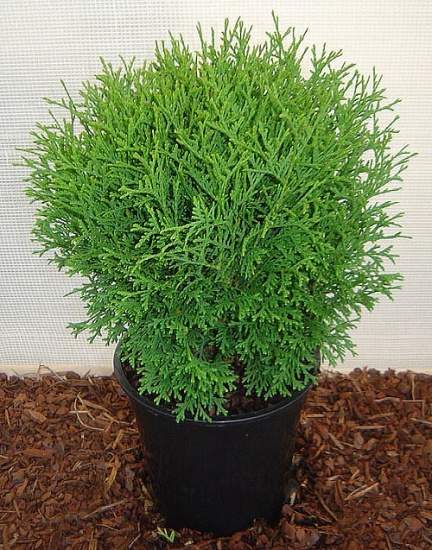

Thuja room
You will not find needles on the tree, the branches are covered with scaly leaves that overlap each other. In the autumn, the thuja begins to bloom, after which small cones form.
Pests and diseases
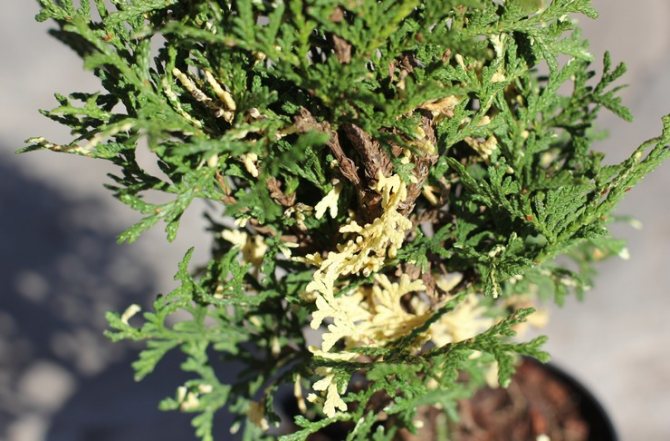

Growing difficulties
The most common problems with breeding cultivated thuja at home are associated with fungal diseases and pests. Due to careless maintenance or overflow, the tree dies. The yellowing of coniferous needles and branches is quite common. The reasons for such changes with the plant arise in a situation where the flowerpot with a tree has been under the scorching sun for a long time. The foliage was severely burned and discolored as a result.Either the pigmentation is caused by the fact that the root collar is too covered with earth, or, conversely, it sticks out high above the surface of the soil. In winter, yellowing of the needles is a common process, so there is no need to panic that the green pet is sick.
Diseases
Thuja branches are susceptible to fungal infections. We are talking about fusarium and cytosprosis. The latter disease harms the cortex. Black streaks form on the surface. Gradually, the spores of the fungus are transferred to the inner layers of the trunk, which will inevitably lead to the death of the culture.
Signs of Fusarium infection are the coloring of the needles in a red or red color, followed by wilting. The disease also affects the underground root of the bush. If measures are not taken in time, the seedling will be difficult to save. Sick specimens must be treated with diluted Bordeaux liquid or Cartocide. Spraying sessions with chemicals are repeated every two weeks until the thuja is fully restored.
Insect attacks
Thuja conifers attract scale insects and bark beetles. Pests, settling on needles, feed on cell sap. As a result, the branches begin to turn yellow. Scales settle on the seed coat and bark. When the bark becomes covered with small holes or narrow corroded canals, you should be afraid of bark beetles. These insects cause irreparable damage to wood. To control insects, chemicals from the group of insecticides are used, which are sold in gardening stores.
The benefits of room thuja
Thuja is not only a spectacular houseplant, it brings practical benefits, releasing phytoncides into the air. These essential oils have a pleasant scent, reminiscent of the scent of spruce resin, and have an antibacterial effect, killing harmful microorganisms in the room.
Many people like the pine forest and the smell of pine needles. Trees of such species grow in open ground and reach impressive sizes in height, so it is very difficult to imagine them in your apartment. Over the past decade, an ornamental coniferous plant belonging to the cypress family has appeared on plots in country houses, as well as on balconies. In this article, we will focus on the room thuja, which has become in demand for its unpretentiousness in growing, its wonderful smell and beautiful appearance.



